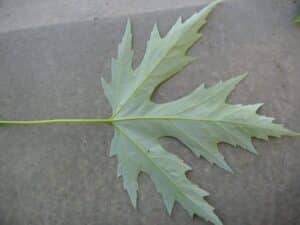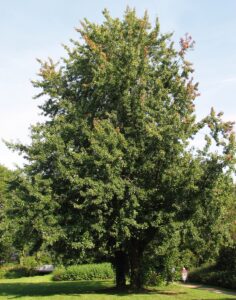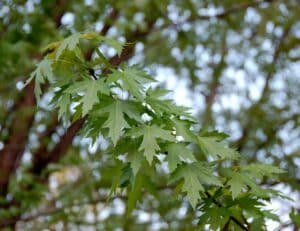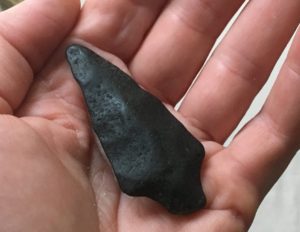Hello, fellow lovers of all things green. Silver Maple, once a Native American treasure, has lost favor in the horticultural industry. Still, I adore its history and marvel over how Mother Nature matched one treasure with another to make a revered tree that is now a trade staple.

Silver Maple Leaf – Photo Credit: Kristian Peters — Fabelfroh 20:06, 31 May 2006 (UTC), CC BY-SA 3.0 via Wikimedia Commons

Silver Maple – Photo credit: Darkone (talk · contribs), CC BY-SA 2.5, via Wikimedia Commons
Silver Maple, Acer saccharinum, is native to the eastern United States and Canada and is often found near water. Hence, other common names include Soft Maple, Swamp Maple, and White Maple. But they are also adaptable to drier areas and require more sunlight than other maples. The top part of the leaf is green, but when the wind blows, the trees seem to sparkle. The bark is silver in color, too, until the tree grows older, when it darkens to grey and becomes shaggy. (Sound familiar? Smile.)
Once a popular street tree
Silver Maple became popular after World War II for their fast growth offering quick shade. They were used as street trees in the suburbs and cities to substitute for the American Elm impacted by blight.
Today, Silver Maple is far less favored. They are banned from being used as street trees in some towns because their wood is brittle and needs pruning to maintain an attractive form. And they’re considered messy, making lots of babies from their pairs of winged seeds over 3 inches long. The autumn color is not a prominent feature either, typically turning pale yellow and dropping earlier than other maples.

Silver Maple Branch – Photo Credit: © Derek Ramsey / derekramsey.com / Used with permission
Mother Nature’s Silver and Red Maple Hybrid
Silver Maple and Red Maple (Acer rubrum) are the only maples that produce seeds in spring instead of fall and can immediately germinate. Their close kinship allowed them to hybridize in nature and has become a trade staple. The hybrid is known as the Freeman Maple (Acer x freemanii) and features fast growth of Silver Maple but with less brittle wood, less invasive roots, and bright red fall color.
Cultivars are sometimes sold under the name Acer rubrum instead of Acer x freemanii, which can be confusing. ‘Jeffersred,‘ with ‘Autumn Blaze’ as a trade name, is one of my favorites, turning into a blaze of orange-red fall color that lasts longer than most.
A Native American Treasure
Native Americans used Silver Maple to make sugar, baskets, and furniture and made cough medicine from the bark. Cape May is a favored spot to find Native American artifacts. We came upon an arrowhead washed up amongst the seaweed on Sunset Beach. There’s something sacred about touching something made by the hands of someone over 2,000 years ago. But be sure to leave it where you found it.
The USDA has a poster. The headline – Just Leave it Be in a big, bold-faced font. It goes on to say that artifacts found on public lands are protected by state and federal laws, making it illegal to take them. They define artifacts as anything used or created by humans, including arrowheads, pottery, coins, baskets, old bottles, and cans. Taking artifacts disrupts the archeological record—the information will be lost forever. You can draw or photograph it. Then, map its location and share that information with your local Forest Service office. But leave it in place, the poster reads in bright red letters.
Just Leave it Be
Shouldn’t we say the same thing about the sculptures of people or books depicting the history of our country? While there are shameful times, we can’t grow forward if we hide it. Leaving history in place and teaching it to our youth will help us not repeat wrongs. With that, we’ll become more civilized in this one world we share – with wildlife and each other. Being civilized, after all, is the root of the word “civilization.”
Garden Dilemmas? AskMaryStone@gmail.com and your favorite Podcast App
Story Updated 11/10/24
There’s more to the story in the Garden Dilemmas Podcast, including a reflection on Pushing Hands of Peace:
I stand corrected :^)

Silver Poplar “Coins” – the underside of Populus alba leaves.
In an earlier version of this story, I thought the trees glimmering on the sides of the road in Cape May, NJ, were Silver Maples. The same tree we had in the yard growing up. Their silvery under-leaf reminded me of shiny silver dollars. I’d pick them for currency and play shop. But I learned they are Silver Poplar, Populus alba, thanks to Marlene and Chris (see comments below.) There’s much to learn in the Garden of Life. Thank you, Marlene and Chris!
Related Stories and Podcast Episyou’llou’ll enjoy:
Anatomy & Array of Beautiful Bark
Ep 148. Anatomy & Array of Beautiful Bark
Wandering Willowwood Arboretum




We have really enjoyed your website ! We are a couple of North Jersey kids from Cliffside Pk originally , we lived down the shore and spent many summers around Cape May. We last lived in Budd Lake, so all your adventures mention so many familiar places ! Thanks for all the gardening knowledge and great memories! Ohio is ok but it will never stack up to Jersey!
Hi Marleen and Chris, I lived in Cliffside Park for 12 years long ago before making my way to Morris County, then Warren County, where my neighbors are cows – farm country! I adore all the personalities of New Jersey. Thank you for your kind words about my website. It means so much, Mary
Mary, I wish more people knew & paid attention to the rules of leaving historic things in place, and I have to agree with you about the statues, etc.
I don’t remember ever seeing silver maples. They look beautiful.
I had to laugh about you saying your neighbors are cows! I think bears would have been more accurate, even though we live in farm country!
Thank you, Diane. I think many of us see the wisdom in preserving history so future generations can learn and grow from it. I sometimes wonder if those who wish to squelch history wish to perpetuate chaos and upheaval. Let us all pray for peace.
Yes, our neighbors are cows (we have two farms just down the road), but bears and the beautiful plants and wildlife are our neighbors, too. I know you cherish them as much as I do. I appreciate your reading, tuning into the story, and taking the time to comment. You are so kind, Mary
Hi again Mary, We’ve been looking at that silver maple tree from Cape May . It truly resembles the white poplar tree. The silver maples we had in Monmouth County and also in Ohio are described as “lobed 4-6” long, oppositely attached, 7 lobes, pointed tips , deep notches and double sided tooth margin. Dull green above with silvery white color below! Please check out the description of white poplar and the photos of them! This really is a curiosity! Thanks for your help!
Oh my goodness, You are right, I have misidentified the cherished tree we had in our yard growing up. My Mom worked at a garden center and adored trees.
“Native to Europe and Asia, it was first introduced into North America in the mid-1700s. It has been widely planted throughout the U.S., and has escaped cultivation and naturalized in many areas, particularly in the East. It is distinguished from other poplars by its 3-5 lobed silvery leaves that are reminiscent of some maples.” Hence why Mom likely called it a Silver Maple.
I went to Cape May Point.org, and Populus alba is on their list of Prohibited Non-native Trees and Woody Plants. It just goes to show how common names are misleading. Thank you for sharing!
There is much to learn in the Garden of Life. Thank you for helping and taking the time to share. The story is now updated :^) Mary